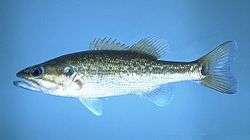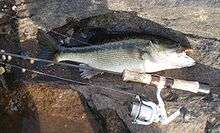Spotted bass
| Spotted bass | |
|---|---|
 | |
| Scientific classification | |
| Kingdom: | Animalia |
| Phylum: | Chordata |
| Class: | Actinopterygii |
| Order: | Perciformes |
| Family: | Centrarchidae |
| Genus: | Micropterus |
| Species: | M. punctulatus |
| Binomial name | |
| Micropterus punctulatus (Rafinesque, 1819) | |
The spotted bass (Micropterus punctulatus), also called spotty, or spots in various fishing communities, is a species of freshwater fish of the sunfish family (Centrarchidae) of the order Perciformes. One of the black basses, it is native to the Mississippi River basin and across the Gulf states, from central Texas through the Florida panhandle. Its native range extends into the western Mid-Atlantic states and it has been introduced into western North Carolina and Virginia. It has also been introduced to southern Africa, where it has become established in some isolated waters. It is often mistaken for the similar and more common largemouth bass.
A convenient way to distinguish between a largemouth bass and a spotted bass is by the size of the mouth. A spotted bass will resemble a largemouth bass in coloration but will have a smaller mouth.
M. punctulatus can reach an overall length of almost 64 cm (25 in), reaching weights of up to 5.2 kg (11 lb). It can reach an age of at least seven years. It is noted for the rows of dark spots below the lateral line, which give it its common name.
Preferring cool and warm mountain streams and reservoirs with rocky bottoms, the spotted bass feeds on insects, crustaceans, frogs, annelid worms, and smaller fish.
In 2010, the scientific community officially recognized a separate subspecies of spotted bass, native to the Tallapoosa and Coosa Rivers, and their lakes. This species is commonly known as the "Alabama spotted bass" (M. henshalli) and known locally as the "Coosa spotted bass", not to be confused with the "red-eye Coosa bass" found in northeast Georgia.[1]
The Alabama spotted is highly prized as a gamefish and average size is much larger than the more common Kentucky spotted bass. The current record spotted bass, caught in pine Flat Lake, California, weighed 10.27 lb.[2]
Description

Many anglers who catch a spotted bass mistake it for a large mouth due to the coloration although there are subtle differences. The spotted bass, like all black basses except the large mouth, has scales on the base portion of the second dorsal fin, its first and second dorsal fin are clearly connected, and its upper jaw bone does not extend back to or beyond the rear edge of the eyes. The spotted bass is also often confused with a small mouth bass or smally for short, but it lacks the vertical bars that are present on the sides of the body of a small mouth bass. The spotted bass also has small black spots below the lateral line unlike either the large or small mouth bass. Juveniles often resemble the young of small mouth bass in having a broad band of orange at the base of the tail, followed by a broad black band and white edge. The spotted bass is known to hybridize with the small mouth, which sometimes makes identification difficult. Spotted mouth bass can be found deeper than small mouth bass at depths up to 100 ft.[3]
Distribution and habitat
Spotted bass seem to segregated by habitat type from closely related species such as the large and small mouth bass. They tend to be found in areas with more current than the large mouth, and usually inhabit areas that are too warm, turbid, and sluggish for small mouth bass. They usually occur around aquatic vegetation, submerged logs, and rock or riprap walls in small to large flowing streams, rivers, and reservoirs. Spotted bass are distributed throughout the Ohio river basin as well as the central and lower Mississippi river basin. The species may be found in Gulf Coast states from Texas east to Florida. Spotted bass are native to portions of East Texas, particularly in the Sabine, Neches, and Cypress Rivers.[4]
Diet
Spotted bass usually feed on small fishes, crayfishes, and aquatic insects.[5] The young begin with copepods and other small crustaceans and soon begin to eat insects. The spotted bass's diet falls in between the largemouth and small mouth bass. It isn't nearly as predatory as the large mouth and only consumes about half the amount of the fish. Like all bass the Spotted bass feeds using suction by opening its mouth and creating a negative pressure that sucks in the prey.[6]
Reproduction and life cycle
The spotted bass can live approximately six years.[7] Spawning occurs from April to May in habitat similar to that used by small mouth. The males builds the nest in gravel or other substrate then entices a female to deposit her eggs. The males guard the eggs until they disperse. Several spotted and small mouth bass hybrids have been collected recently in area reservoirs suggesting there is occasionally competition between the two species for spawning habitat.[8]
Importance to humans
Spotted bass is a game fish that is fished for regularly. In this context Spotted bass is a good food source for humans.
Etymology
Micropterus means small fin
punctulatus means dotted[5]
See also
References
- ↑
- ↑
- ↑ "Bass, spotted". Igfa.org. Retrieved 2016-10-19.
- ↑ "Spotted Bass (Micropterus punctulatus)". Tpwd.texas.gov. Retrieved 2016-05-04.
- 1 2 "Spotted Bass". Outdoor Alabama. 2014-07-16. Retrieved 2016-05-04.
- ↑ "Spotted (Kentucky) Bass Freshwater Fish Information". Fish-identification.com. Retrieved 2016-05-04.
- ↑ "Spotted Bass | MDC Discover Nature". Nature.mdc.mo.gov. Retrieved 2016-05-04.
- ↑ "TWRA - Tennessee Wildlife Resources Agency - Spotted Bass". Tnfish.org. Retrieved 2016-05-04.
External links
- FishBase: Micropterus punctulatus
- "Micropterus punctulatus". Integrated Taxonomic Information System.
- Rohde, F. C., et al. Freshwater Fishes of the Carolinas, Virginia, Maryland, and Delaware. Chapel Hill: University of North Carolina Press, 1994, ISBN 0807821306
| Wikimedia Commons has media related to Micropterus punctulatus. |